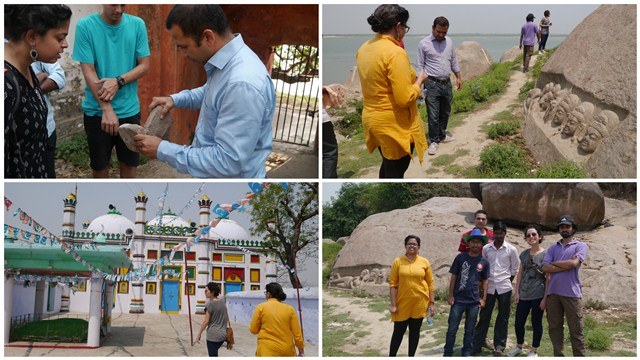SHS Field Trip to Munger, Kharagpur, Sultanganj, and Lakhisarai
May 1, 2017
By Azad Hind Gulshan Nanda, School of Historical Studies, Class of 2017
The School of Historical Studies (SHS) conducted a two-day field trip to Munger, Sultanganj, Kharagpur and Lakhisarai during 14-15 April 2017 as a part of the elective course Rivers of Monsoon Asia offered by Dr. Murari Kumar Jha, Assistant Professor, SHS.
The objective of the trip was to provide the students a deeper, on-ground understanding of the economic, political, and religious landscapes of the region to the south of the Ganga River. The theme of the visit was centred on the Ganga, its past function as a major riverine route in pre- and early modern India. It also focussed on how the river historically fostered the development of overlapping networks of trade, pilgrimage, religion, and politico-military activities along the eastern tracks of the Ganga River.
Mr. Chandrashekharam, a journalist and social activist working in the field of heritage and culture in Munger, also joined the group.

Students from Nalanda’ University during their field trip to Munger, Sultanganj and Lakhisarai – Pic Credit: Azad Hind Gulshan Nanda
The trip began with a visit to the Munger Fort and Pir-Pahari. The Munger Fort is an iconic structure and the foundation of the outer walls appears to be of pretty remote antiquity. The fort remained strategically important for many centuries since the early medial period up to the mid-eighteenth century when Mir Qasim fought with the English Company in 1763. We walked along the banks of the Ganga and observed the ruined outer walls of the fort. We also held several on-site discussions on the issues related to the architecture of the fort, the opening of the landing Ghats, the customs posts on the river, significance of fortification for the Mughals, and so on. Given the historical importance of the Munger Fort, the group made recommendations for its restoration and proper conservation. Also, given the natural beauty of the place with river on one side and the hills on the other, the group would like to formally request the Bihar state tourism authorities to develop the fort as a tourist attraction.
The next stop of the day was Pir-Pahari, which is located at a little distance from the main city. It is a hill that has the tomb of Gurgeen Khan, the famous general of Mir Qasim. It also has an extended brick mound with fragments of carved marbles that appear to be from the early centuries CE. The day ended with a visit to Haveli Kharagpur (34 Kilometres from Munger) and a beautiful large lake on the top of the hills serving the needs of irrigation for the peasants in the area.
On the second day of the trip, we visited Sutanganj (36 Kilometres from Munger) and the newly discovered sites and temples at Lakhisarai. The sites we visited include Sultan Dargah housed in the premise of a seventeenth century mosque and the rock cut images in Sultanganj (also called Jahangeera Rocks in the early modern records), and Ashokadham temple and structural remains on Jaynagar hills in Lakhisarai. During the trip, we were introduced to rich historical, artistic and religious traditions of the region which had been long exposed to manifold interactions with other regions and cultures through the riverine and overland trade routes. We also interacted with various state officials, archaeology enthusiasts, and the patrons of the site temples and monuments which further added significant value to the trip.